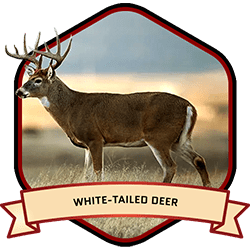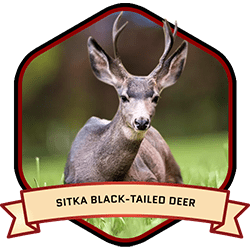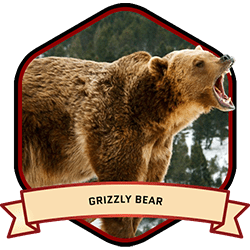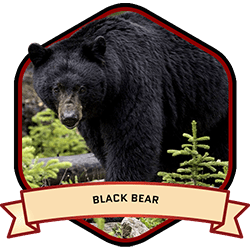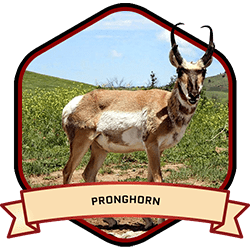SUPER SLAM 29 of
NORTH AMERICA
#1 – White-Tailed Deer
Whitetails typically reach a weight of 110-300 pounds and an average height of 6-7 feet. It is considered the most hunted big game animal in North America. Whitetails have impressive leaping capabilities. They can reach a speed up to 40 mph and can leap a remarkable 8 feet into the air, while covering a span of 30 feet.
<– Click on the White-Tailed Deer for more information.
#2 – Mule Deer
On average, a mule deer weighs between 130-300 pounds and can measure up to 5 feet tall from the shoulder. They can speed up to 40 mph but won’t be able to maintain it for long distances. They will bound away in a series of leaps known as stotting and can cover up to 25 feet in a single leap.
<– Click on the White-Tailed Deer for more information.

#3 – Coues White-Tailed Deer
Coues are the smaller cousins of whitetails, with adults reaching a height of only up to 34 inches at the shoulder and seldom exceeding 100 pounds. But what they lack in size, they make up for the challenge they present. Coues are elusive and have a remarkable ability to disappear into their habitat of mostly rugged terrain and harsh climate.
#4 – Columbia Black-Tailed Deer
Columbian black-tailed deer varies in weight ranging from about 150-200 pounds. With its home as its biggest defense strategy, they are often referred to as ghosts of the forest. Unlike the mule deer that will bound off to escape a threat, Columbian blacktails tend to be more discreet, taking cover and sneaking away quietly.
<– Click on the Black-Tailed Deer for more information.
#5 – Sitka Black-Tailed Deer
Adult bucks average between 120-200 pounds, while does are much smaller at 80 pounds. The Sitka black-tailed deer are stockier, and have much smaller faces compared to the Columbian black-tailed deer. This specie tends to shy away from aggression and will rather bolt or take cover when it senses danger.
<– Click on the Black-Tailed Deer for more information.
#6 – Rocky Mountain Elk
The Rocky Mountain elk have the largest population and are the most common hunted of all subspecies. An adult cow will weigh about 500 pounds and stand 4.5 feet at the shoulder while an adult bull will weigh about 700 pounds and stand 5 feet tall at the shoulder. As a social animal, herds are large and can consist as many as 25 cows, calves, and yearlings. A “lead cow”, usually an older and experienced cow that has memorized key trails, leads the herd where to move, eat, and bed. These lead cows can make it challenging for hunters to sneak in within shooting range.
<– Click on the Rocky Mountain Elk for more information.
#7 – Roosevelt Elk
Roosevelt elk is the largest subspecies of the North American elk. A mature bull weighs about 1,200 pounds, stands up to 5.6 feet, and measures about 6-10 feet in length. Cows are generally smaller, weighing between 500-600 pounds. Roosevelt elk typically roam at dawn and dusk; and tend to stay hidden within their Pacific forests when threatened.
<– Click on the Roosevelt Elk for more information.
#8 – Tule Elk
The Tule elk is endemic to California. It is considered to be the smallest species of the North American elks, with mature bulls weighing about 550 pounds and cows about 400 pounds. Both can reach up to 7 feet in length and 4-5 feet tall from the shoulder. The biggest challenge in hunting this elk is not always in getting within shooting distance; the smartest and the biggest of the herd will hole up in thick cover that it will be almost impossible get a clear shot.
<– Click on the Tule Elk for more information.
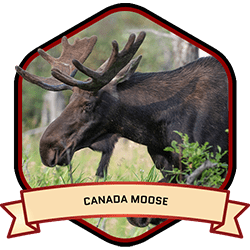
#9 – Canada Moose
Moose are typically solitary unlike the whitetails and elk, making them more difficult to hunt. They are the largest of the deer family, reaching a height up to 7 feet and can weigh as much as 1,500 pounds. Although they may seem gentle, they can become aggressive especially during mating season. Moose have great endurance and can maintain a speed of 35 mph.
#10 – Shiras Moose
Despite being known as the smallest moose of North America, the Shiras moose is still quite large. A mature bull can reach a height up to 7 feet tall at the shoulder and up to 10 feet in length. It can weigh around 600-1,400 pounds while a mature cow can weigh around 500-1,200 pounds. Antlers can weigh up to 50 pounds and can span up to 5 feet.
<– Click on the Shiras Moose for more information.
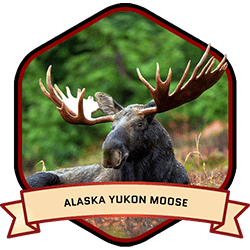
#11 – Alaska Yukon Moose
The Alaskan Yukon moose is the largest of all North American moose, with mature bulls standing up to 7.5 feet and weighing as much as 1,800 pounds. As with all moose its acute senses of smell of and hearing make up for its poor vision. Despite its large stature, this moose is agile and can maintain a speed of 35 mph for a considerable distance.
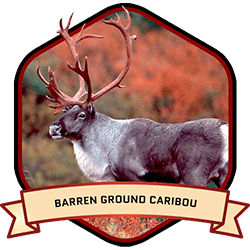
#12 – Barren Ground Caribou
Known as the iconic migrators of Alaska, the Barren Ground caribou have incredible endurance covering vast territories. A typical herd can consist of 100,000 animals. A mature cow can weigh between 175-225 pounds while bulls average to about 350-400 pounds. The caribou is the member of the deer family where both males and females grow antlers.

#13 – Central Canadian Barren Ground Caribou
This member of the deer family is a medium-sized caribou with weights ranging from 225-475. This caribou typically prefers tundra and arctic islands.

#14 – Woodland Caribou
The woodland caribou is one of three regional caribou categories established by the Boone & Crockett Club. The two other categories are the mountain caribou and Quebec Labrador caribou. The woodland caribou grow the smallest antlers. An average adult weighs about 350-450 pounds, with a height up to 5 feet at the shoulder and reaches a length up to 7 feet. Herds are typically small and mostly non-migratory, preferring tundra and forested habitat.

#15 – Mountain Caribou
With bulls weighing as much as 600 pounds, the Mountain caribou is the largest of its type. They also grow the heaviest antlers and are known for very strong top points.

#16 – Quebec Labrador Caribou
Mature bulls average between 200-450 pounds in weight. Highly migratory, this caribou has the world’s longest known migration of up to 3,000 miles. The general decline in caribou population has prompted its hunting to be limited, if not at all closed.

#17 – Polar Bear
The Polar bear is arguably the world’s biggest land-based carnivore. An adult male can weigh about 900-1,000 pounds, reaching a length up to 8-9 feet in length. Females are considerably smaller weighing around 330-550 pounds and measuring up to 6-8 feet in length. A polar bear can swim at 6 mph for as much as 40 miles. Its running speed is also at an impressive 25 mph. Although walruses and wolves can sometimes kill it, with its immense size and power, the polar bear has no natural predators.

#18 – Alaska Brown Bear
The Alaska brown bear, with the exception of the polar bear, is one of the largest types of bears. An adult bear average to about 800-1,000 pounds, measuring up to 8 feet in length. It is typically solitary except when mating and when forced by circumstances to share food sources. While its eyesight is only average, it has a keen sense of smell and hearing. Typically, they walk slow but are capable of running up to 30 mph.
#19 – Grizzly Bear
Grizzly bears can weigh nearly up to 800 lb and when threatened, can stand as tall as 13 ft! Although big and heavy, these animals can run upward with a speed up to 30 mph. Grizzly bears are considered dangerous and aggressive and can easily take down larger animals.
<– Click on the Grizzly Bear for more information.
#20 – Black Bear
The black bear is generally harmless and can coexist with humans. But because of this same reason, black bear attacks, with some fatalities, are more common compared to grizzly bear attacks. With a top speed of 35 mph, weighing between 600-800 lb, and standing up to 6 ft tall, the black bear isn’t the easiest to take down at all.
<– Click on the Black Bear for more information.
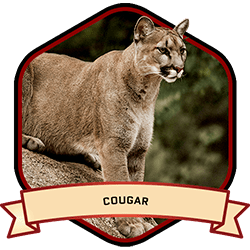
#21 – Cougar
The cougar is called by several names including puma, mountain lion, and sometimes panther. In North America, an adult cougar can measure up to 6-8 feet in length and can weigh up to 100-150 pounds. Females are roughly 40 percent smaller than males. While generally not aggressive to humans, attacks can happen especially in areas where there is overpopulation of the cats. They can speed up to 40-50 mph; they can also leap up to 40 feet horizontally and can jump upward 18 feet vertically.

#22 – Muskox
The muskox is named after the strong, musky odor the male’s facial glands emit during the rut. Mature bulls can weigh between 600-800 pounds and are about 5 feet high at the shoulder. Cows are considerably smaller, weighing between 400-500 pounds and about 4 feet in general. It is typically slow and calm, but when threatened, it can charge at least 25 mph and run a considerable distance at 15-20 mph.
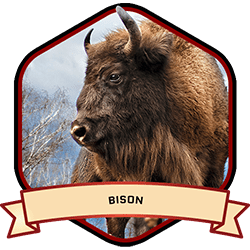
#23 – Bison
Bison may be North America’s largest land animals, but that doesn’t stop them from being agile and quick. They can reach a speed up to 35 mph if provoked, which makes it almost impossible to escape a determined charge. An adult female can measure up to 4-5 ft, and can weigh as much as 1,000 lb. Adult males are much bigger, measuring up to 6 ft tall and weighing as much as 2,000 lb.
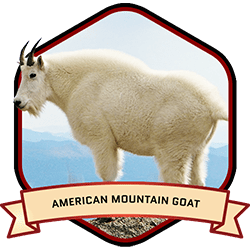
#24 – American Mountain Goat
The American mountain goat can weigh up to 300 pounds, reaching a shoulder height of 35-40 inches. Both males and females grow short, sharp, and black horns. Their formidable habitat—the rugged and alpine environment—arguably makes mountain goat the toughest and most dangerous North American big game animals.
#25 – Pronghorn
<– Click on the Pronghorn for more information.

#26 – Rocky Mountain Bighorn Sheep
With mature males weighing an average of 200-250 pounds, sometimes even 300 pounds, the Rocky Mountain bighorn is North America’s largest sheep. Equipped with eyes that provide them wide-angle vision plus acute senses of smell and hearing, it can detect threats from a long way off.
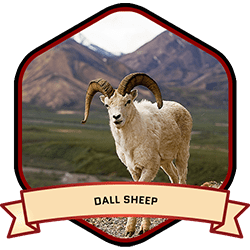
#27 – Dall Sheep
An adult Dall sheep reaches a length of up to 4.6 feet and weighs about 150 pounds. The Dall sheep have white coat and curled amber horns. They are highly adapted to alpine environment, including glacier edges and are mostly hunted for the challenge they present.

#28 – Desert Bighorn Sheep
The Desert bighorn sheep is highly adapted to hot, dry environment with limited vegetation and water. Adult rams can weigh between 160-200 pounds, while females are considerably smaller, ranging from 75-130 pounds. Except during mating season, the ewes and lambs are typically segregated from the lambs to minimize risk of predation. Compared to the Dall sheep, hunting permits for the Desert bighorn is limited, so it is often the biggest hurdle to achieving the Grand Slam.
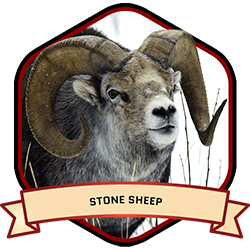
#29 – Stone Sheep
An adult ram on average will weigh about 180-220 pounds, although sometimes they can reach up to 250 pounds and even more; they stand 40 inches tall at the shoulder. Ewes are considerably smaller, weighing 30-40% less and standing 36 inches tall at the shoulder. The Stone sheep can mainly be distinguished from the Dall sheep by its color, varying from shades of grey/brown and sometimes nearly black. This sheep prefers environment that are rugged and at high altitudes. Its acute senses of vision, smell, and hearing will alert them quickly for any predators or hunters, making them even more challenging to hunt.

